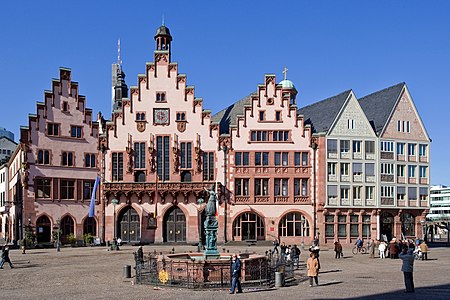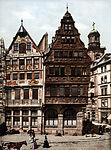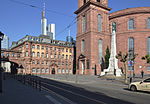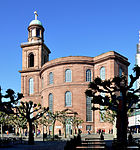Römer

The Römer (German surname, "Roman") is a medieval building in the Altstadt of Frankfurt am Main, Germany, and one of the city's most important landmarks. The Römer is located opposite the Old St. Nicholas church and has been the city hall (Rathaus) of Frankfurt for over 600 years. The Römer merchant family sold it together with a second building, the Goldener Schwan (Golden Swan), to the city council on March 11, 1405 and it was converted for use as the city hall. The Haus Römer is actually the middle building of a set of three located in the Römerberg plaza. The Römer is not a museum as it is occasionally used by the city for various purposes, for example as a Standesamt or civil registration office; the wedding rooms are located in the first and second floor of the Haus Löwenstein. The former old town quarter between the Römer and St. Bartholomew's Cathedral has been redeveloped as the Dom-Römer Quarter until 2018, including several reconstructions of historical buildings that were destroyed during World War II.
Excerpt from the Wikipedia article Römer (License: CC BY-SA 3.0, Authors, Images).Römer
Limpurgergasse, Frankfurt Altstadt (Innenstadt 1)
Geographical coordinates (GPS) Address Nearby Places Show on map
Geographical coordinates (GPS)
| Latitude | Longitude |
|---|---|
| N 50.110277777778 ° | E 8.6816666666667 ° |
Address
Haus Silberberg
Limpurgergasse 2
60311 Frankfurt, Altstadt (Innenstadt 1, Innenstadt)
Hesse, Germany
Open on Google Maps











